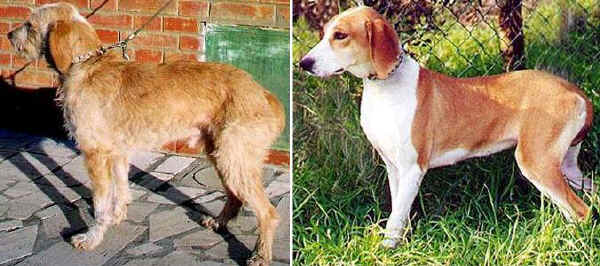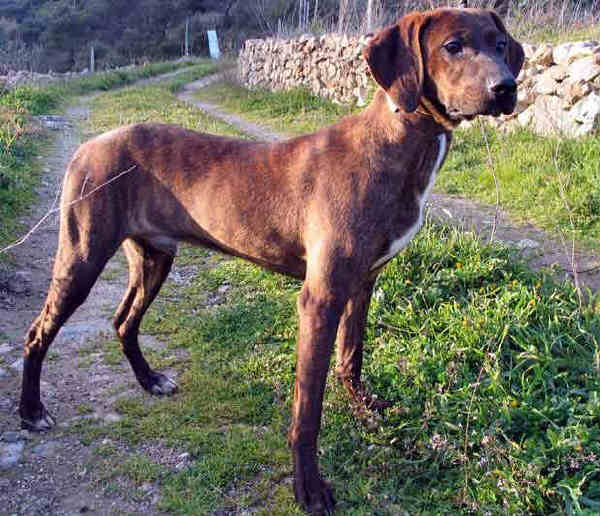Segugio Maremmano - Maremma Scenthound
Italian breeds of dogs
Origin, classification and brief historical summary
Origin: Italy.
Classification F.C.I.: Group 6 - Scenthounds and related breeds.
Maremma Scenthound breed comes from Maremma, where it was selected by the end of 1800, not only because of its morphological characteristics but most of all because these dogs bark keeping still. Most suitable for the boar hunt, they do not give up either in case of consistent groups or particularly aggressive boars. Quite good at hare shooting and other mammals hunt. This breed has been recognized by ENCI only recently and it seems to be quite popular.
Smaller than the Italian Segugio, it is different from it in the head, which is not so noble, in the colour, which varies from tawny to seal-black, also striped, and in the tail, which is often cut.
Resolution ENCI n° 192 07/07/2003: Maremma Scenthound short-haired (tawny), short-haired (seal-black), short-haired (striped) and rough-haired (tawny).
General appearance
Medium sized dog; it is not a beautiful dog but it is very skilful. Rustic, mesomorphic, the trunk fits into a rectangular; the head with quite a large cranium.
Behaviour and temperament
This breed is particularly good at boar hunting. Strong temperament, pleasant ringing voice, very different during the hunt various moments. It hunts on its own or in a pack.
 Segugio Maremmano rough-haired and short-haired (photo www.prosegugio.it)
Segugio Maremmano rough-haired and short-haired (photo www.prosegugio.it)
 Segugio Maremmano short-haired (photo www.prosegugio.it)
Segugio Maremmano short-haired (photo www.prosegugio.it)
Standard
Size:
- males from 44 to 52 cm;
- females from 42 to 50 cm.
Weight: from 13 a 23 kg (13 kg minimum for females and 23 kg maximum for males).
Trunk: stout built, its length is 1/10 the height of the withers, without losing harmony and balance. The withers are just a bit raised on the back bearing near shoulder-blades. The chest is well developed in the three dimensions, with ringed ribs; the breast bone is moderately towards the abdomen, which is never withdrawn. Good balance of length and width of the rump.
Head and muzzle
Brachycephalic head, the total length is 4/10 the height of the withers, it must not be lined with wrinkles, the skin must be adherent to the tissues. The muzzle measures 1/12 the length of the head. Slightly convex or straight nose. Fine and thin lips, never leaning, the rims of the lips are always black. Eyes: a bit oval shaped, in semi-lateral position, of a dark colour with a lively and alert look showing cleverness; the rim of the eyelids are black. Flat ears, with a broad join over the level of the eyes, well adherent to the jaws, of triangular shape.
Truffle: all along the same line of the nose, it has a broad rim and large well opened nostrils, always moist and cool, always black.
Teeth: white, regularly aligned, complete and normally developed, scissors bite is correct, pincer bite is allowed. The neck has the shape of a truncated cone, a bit shorter than the total length of the head, thin with good muscles, absolutely without dewlap.
Skin: fine, close fitting all over the body.
Quarters: forequarters endowed with very good long and lean muscles; loose articulation of the shoulders, elbow well fitted in the chest, forearm perpendicular to the ground. Oval shaped foot with tightly closed toes and tough pad, strong nails, usually black.
Hindquarters have good angles of articulation, in a perfect vertical line perpendicular to the ground. The hindfoot is less oval than the front foot of which it has all the characteristics. Marked muscles in the thigh. Dewclaw permitted. Loose and lively gait.
The topline is straight.
Tail: it may be cut off a bit lower than the half of its length. It is set high on the line of the rump; in the examples with long tail it is gradually tapering towards the tip, never fringed. Anurans are permitted.
Coat: there are two kinds of coat, the short-haired and the rough-haired. In the short-haired straight horse hair texture, dense, equally covering the whole body, no defences or just hinted, quite often there may be a few scattered coarse hairs
on the muzzle and on the legs (1-1.5 cm). In the rough-hair variety its length is from 3 to 4 cm all over the body, rough by touch.
Colour: the allowed colours are from intense fawn, to the faded fawn, black and tan and striped. These dogs may have white in the right places, e.g., on the legs, from carpus to foot and tarsal to foot, on the neck, a white star on the chest. A strip on the forehead and the tip of the tail.
Recurrent faults: disqualifying faults: undershot and overshot mouth, concave muzzle, either incomplete or hidden testicles not fully descended into the scrotum.; different colours from those acceptable, strong depigmentation, wall eye.
Eliminating faults: cranial-facial axes convergent, height and weight exceeding the indicated limits.
www.prosegugio.it - S.I.P.S. Società Italiana Pro Segugio "Luigi Zacchetti"

